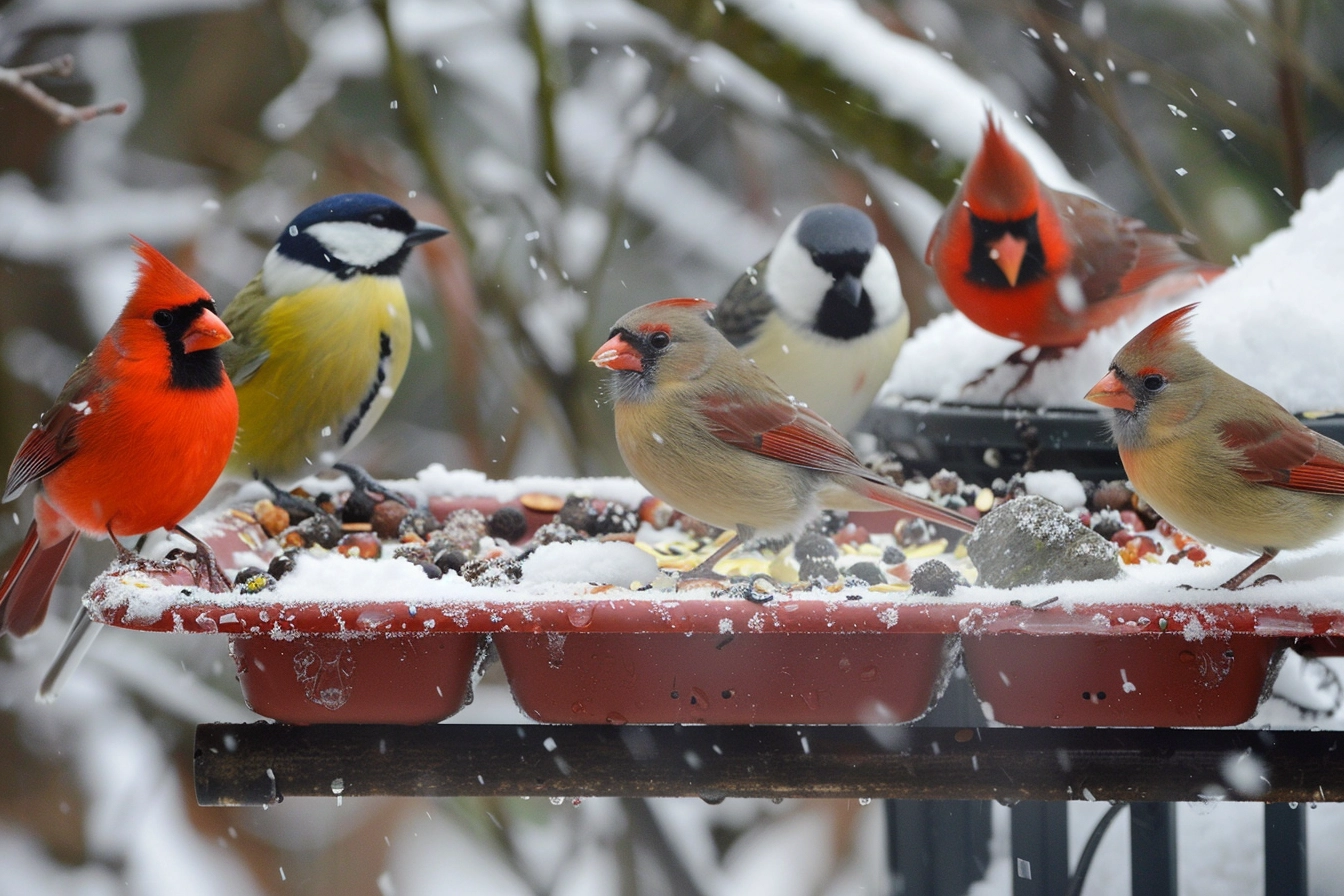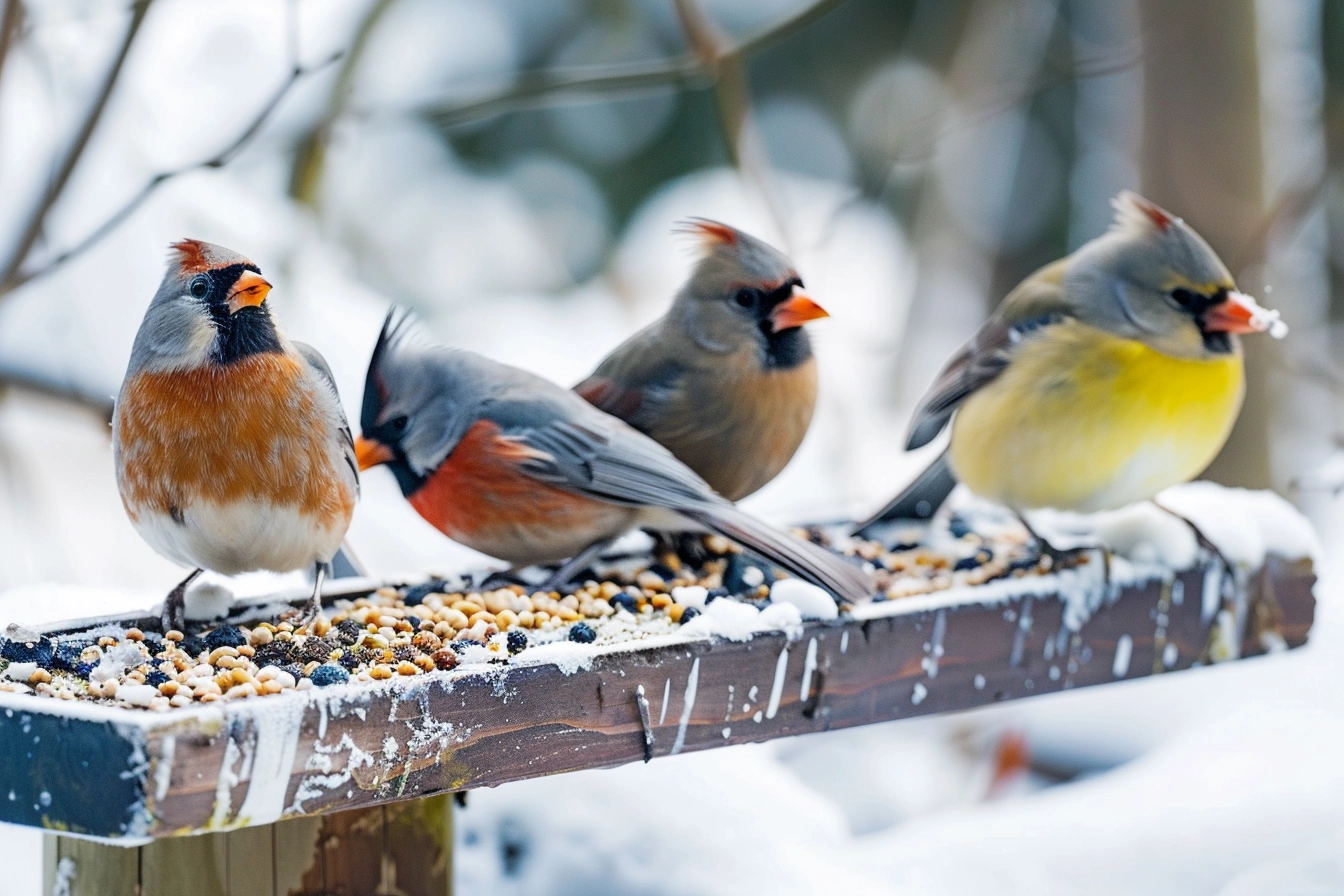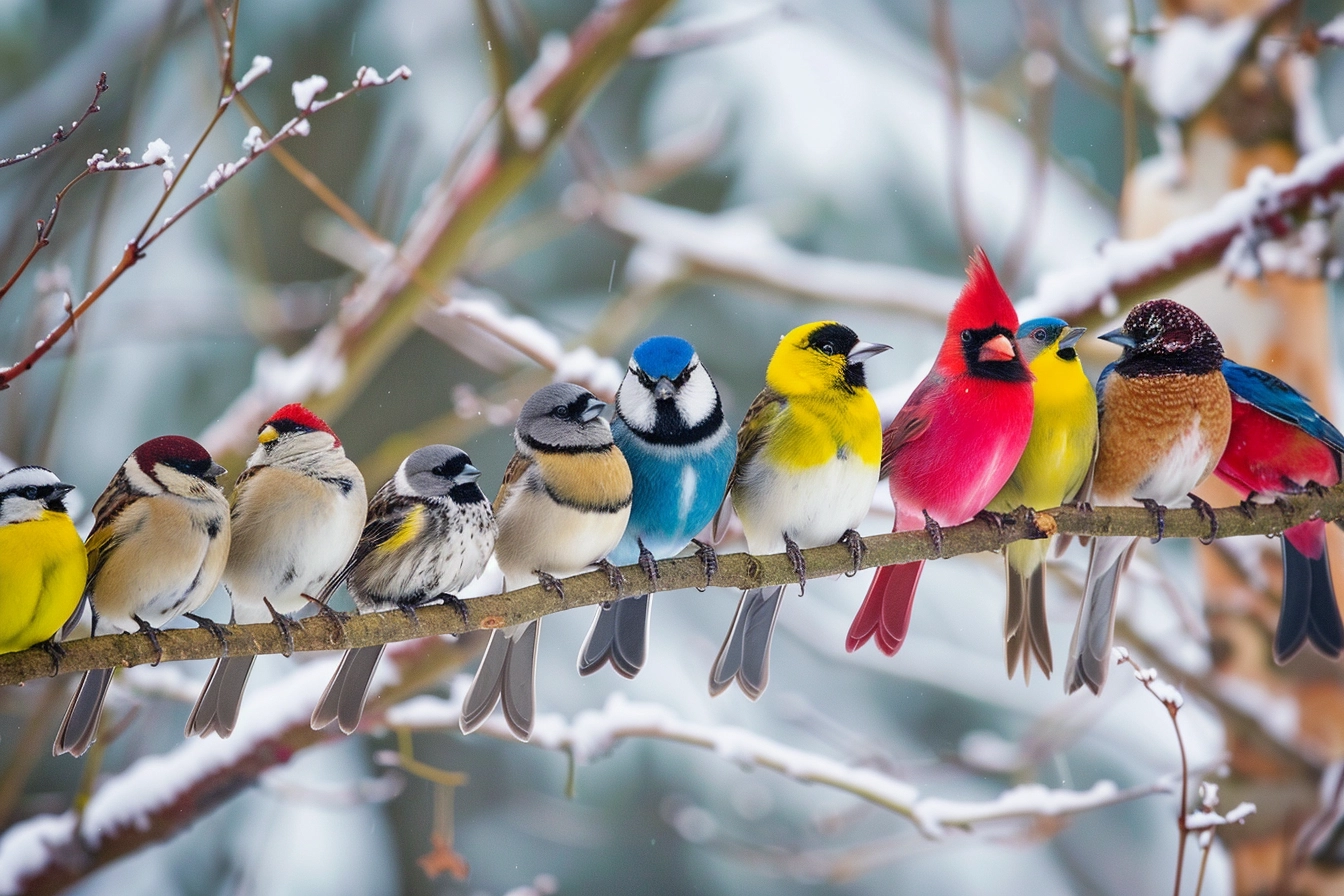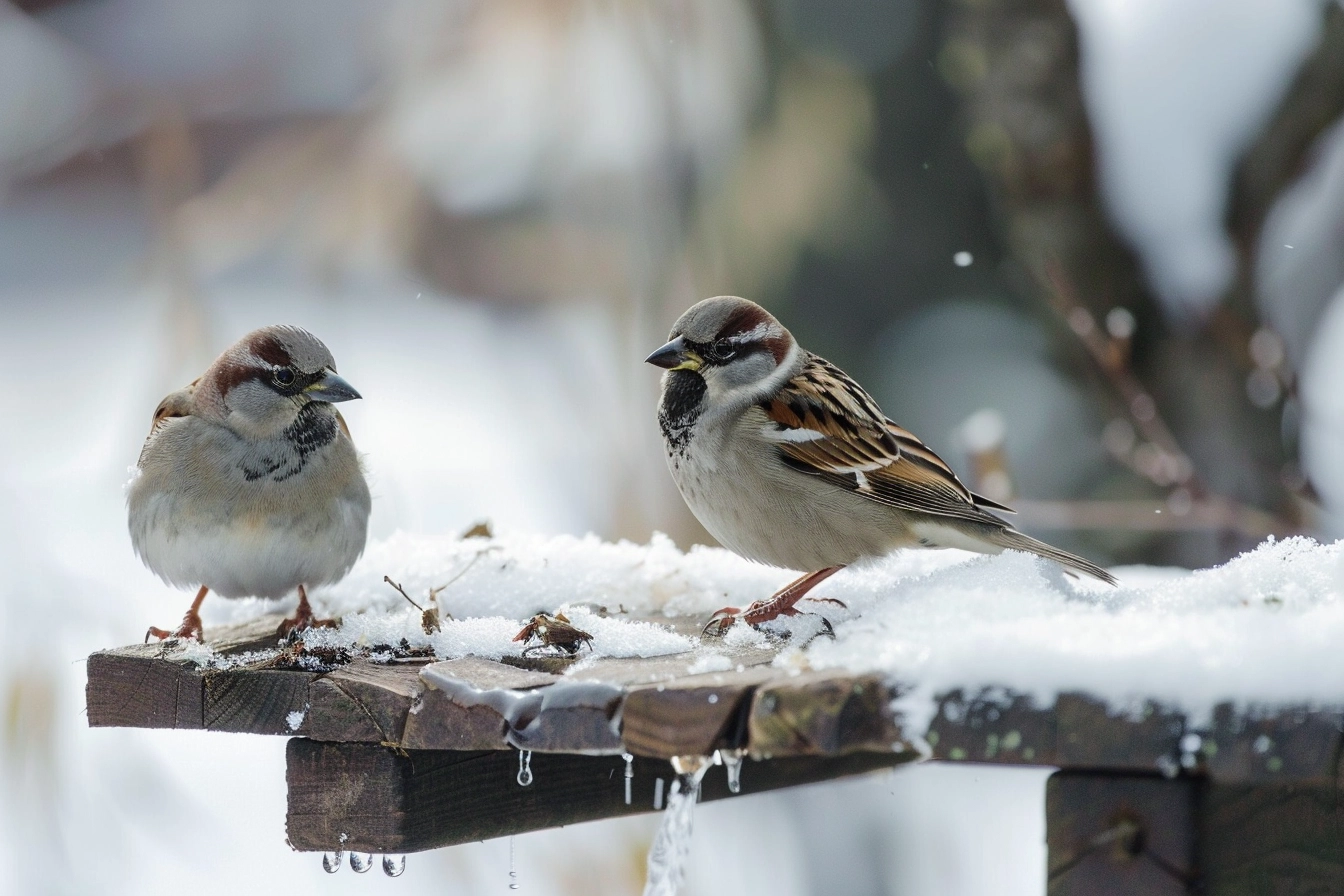Caring for backyard birds during the cold weather is a rewarding experience that provides vital support to these feathered friends.
As temperatures drop, birds require extra energy to maintain their body heat and survive the harsh conditions.
By being mindful of their needs, you can make your backyard a winter haven for birds.
Heated bird baths, as recommended by Birds and Blooms, can provide an essential and life-sustaining resource for birds to drink from during freezing temperatures.
Ensuring that water remains unfrozen is as crucial as nutritious food, allowing them to reserve energy for warmth.
In addition to addressing their need for water, your feeding practices should adapt to the winter’s demands.
Energy-rich foods such as suet, black oil sunflower seeds, and peanuts offer the high-calorie intake necessary for birds to endure the cold.
Providing adequate shelter is paramount for birds to escape the elements and roost safely at night.
Arranging roosting boxes or leaving natural shelters such as dense shrubbery can encourage birds to stay close while keeping them protected from the cold and potential predators.

Key Takeaways
- Provide unfrozen water and high-calorie foods to help birds maintain energy and stay warm.
- Offer shelter with roosting boxes or natural coverings to protect birds from harsh weather.
- Monitor backyard bird activity to ensure a safe and supportive environment throughout winter.
Understanding Your Backyard Birds
In the chilly months, your backyard becomes a sanctuary for various bird species, each with its unique needs and behaviors.
Learning about the birds that frequent your area and how they survive winter can greatly enhance your ability to care for them.
Common Winter Species
Sparrows and juncos are hardy winter visitors that often forage on the ground for food.
Finches, including the vibrant goldfinches, adapt to the colder weather by changing their bright summer plumage to a duller color, which helps with camouflage.
Chickadees and titmice are active and sociable birds, easily identified by their curious nature and frequent visits to feeders.
Woodpeckers continue their search for insects in tree bark, providing the percussive backdrop to a winter’s day.
Raucous jays and secretive nuthatches also make an appearance, with nuthatches being known for their head-first descent down trees.
The striking cardinals, with their bright red feathers, stand out against the snow, often pairing up throughout the season.
These small birds bring life to your winter garden and rely on it for survival.
Birds’ Winter Needs
During winter, birds face two main challenges: staying warm and finding enough food.
Their bodies are well-adapted to this through behaviors like shivering to generate heat and fluffing up their feathers to create insulating air pockets.
However, they still require your help.
Offering a variety of seeds is crucial, as finches and sparrows may prefer sunflower seeds, while juncos and woodpeckers might seek out suet or mixed seeds.
Titmice and chickadees are regularly seen taking sunflower seeds one at a time, shelling them in a secure spot.
Adding a clean and unfrozen water source is also beneficial for these birds to drink and bathe, maintaining their feather condition for insulation.
A consistent food supply encourages regular visits and helps your feathered friends reserve energy for warmth rather than foraging far and wide.

Feeding Practices
Proper feeding practices are crucial to ensure the birds in your backyard remain healthy and well-nourished during the cold months.
Choosing the Right Food
To support birds during winter, prioritize foods high in fat and protein.
Consider suet, which offers much-needed energy, black oil sunflower seeds, a favorite among a variety of species, and a mix of nuts and peanuts, which are ideal for their high fat and protein content.
- Key foods to include:
- Suet
- Sunflower seeds
- Peanuts
- Nut blends
- Protein-rich food such as dried mealworms
Feeder Types and Placement
Different birds have different preferences.
Ground-feeding species like sparrows enjoy scatterings of cracked corn on the ground, while others prefer elevated platforms or hanging feeders.
To reduce window collisions, place your bird feeders less than 3 feet from a window or more than 30 feet away.
- Feeders by bird type:
- Ground feeders: Scatter cracked corn or seeds
- Elevated platforms: Suet, peanuts, black oil sunflower seeds
- Hanging feeders: Nut blends, suet cages
Maintaining Cleanliness
Keeping feeders clean is vital to prevent the spread of disease.
Regularly sanitize them with a solution of nine parts water to one part bleach.
Ensure that the seeds stay dry to prevent mold, which can be harmful to your feathered guests.
Remember to keep the area around the feeders tidy to deter pests like squirrels.
- Cleanliness tips:
- Sanitize feeders periodically
- Keep seeds dry to avoid mold
- Clean the surrounding area to avoid attracting rodents
Providing Water
In the winter, your backyard birds need a reliable source of water for drinking and bathing.
Ensuring continuous water access is crucial as natural sources may freeze.
Water Sources
Choose a bird bath as your primary water source; birds are familiar with this setup for drinking and preening.
Make sure the water is fresh and replenish it frequently.
Providing birds with water during cold months can be a lifesaver, and a heated bird bath is particularly effective at attracting a wide variety of birds to your yard.
Keeping Water from Freezing
A heated bird bath is essential to prevent water from freezing.
If you’re not using a heated bird bath, place your bath in a sunny area to slow down the freezing process.
Adding a few stones or sticks to the bird bath can help birds drink without getting wet.
Regular maintenance to remove ice with warm water or a scraper keeps the water source available.

Creating a Safe Environment
Creating a safe environment for your backyard birds during the cold weather is crucial. It involves providing adequate shelter, safeguarding them from predators, and ensuring there are sufficient natural food sources.
Shelter Options
To support birds in the cold months, provide shelter options that conserve heat and offer protection from the elements.
Birdhouses and roosting boxes serve as excellent refuges, especially if designed with insulation to retain warmth.
Placing them at various heights caters to different species’ preferences.
In addition to man-made structures, dense evergreens and brush piles create natural havens where birds can seek shelter against harsh weather.
Protecting from Predators
Ensuring protection from predators is vital.
Place shelters such as birdhouses and ground feeders in locations that are difficult for predators to access.
Nearby brush or branches offer a quick safe haven but should not facilitate predators’ approach.
Habitats closer to human activity tend to discourage some predators, while the proximity to cover like a brush pile can provide an emergency escape route.
Supporting Natural Food Sources
During winter, food can be scarce for birds.
Plant native plants that bear berries and fruit in different seasons to ensure a year-round supply.
Evergreens and shrubs not only offer shelter but can also provide firs and berries, critical natural food sources.
Supplementing with a ground feeder filled with appropriate seeds and nuts aids birds when natural foods are less available, making your backyard a reliable habitat.

Health and Well-being of Backyard Birds
Maintaining the health and well-being of backyard birds during cold weather involves proactive measures to prevent diseases and accidents.
Ensuring a safe and healthy environment is essential for their survival.
Preventing Diseases
To reduce the risk of disease transmission among birds, regular cleaning of feeders and bird baths is crucial.
Use a solution with one part bleach to nine parts water to eliminate bacteria and mold growth, which can be harmful to birds’ health.
Rinse feeders thoroughly after disinfecting to ensure no chemical residue remains.
It’s best to clean your feeders at least every two weeks or more frequently if usage is high.
- Weekly Cleaning Steps:
- Empty the feeder of any seed or debris.
- Scrub with soapy water to remove visible dirt.
- Soak in a disinfecting bleach solution.
- Rinse thoroughly with clean water.
- Allow to air dry before refilling with seed.
Avoiding Accidents
To minimize accidents, place bird feeders at a safe distance from windows to prevent collisions.
The reflection on the glass can confuse birds, leading to fatal accidents.
You can also apply decals or other visual cues to make windows more visible to flying birds.
- Window Safety Tips:
- Position feeders less than 3 feet or more than 30 feet from windows.
- Apply visible decals on the glass.
- Close curtains or shades to reduce reflection.
- Install external screens to cushion the impact for birds.
